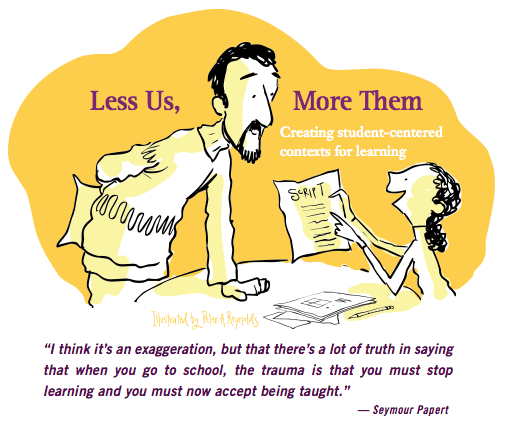When I reflect back on what we were able to accomplish at New Milford High School, I am overtaken by a great sense of pride. We were able to transform the learning culture of a traditional school and in the process got results while becoming an example that others emulated. This was achieved during a time of tumultuous change as the education reform movement was just gaining steam. Even when doubt entered out minds, which it always does when change is involved, we persevered as a school community thanks to a unified vision that we could better serve our students.
In a sense, all of our major changes really started when we began involving our students in the process. This was also the reason, in my opinion, as to why change became sustainable. More often than not change is orchestrated and directed at the adult level. There is often a great deal of talk about how many changes are being spearheaded for the betterment of students, but rarely are the students themselves asked for their input or unique ideas. Schools need to work for our students, as they are our number one stakeholder and ultimate boss.
If we are to improve learning and ultimately school-based outcomes student agency needs to be a real element of school culture. Student agency is about empowering kids to own their learning (and school) through greater autonomy. It is driven by choice, voice, and advocacy. We learned a great deal about student agency during our school transformation. Below are a few practical tips to make student agency a reality in your classroom, school, or district:
Above are some of the ways we increase student agency. What would you add? Please share some of your ideas in the comments below.
Meaningful change must begin with active student involvement. Advocacy, choice, and voice should occur in the classroom as well as the school setting. Relevancy and value on the part of our learners are central elements to success. Let’s move away from the catchy sound bites and clichés and begin to implement real strategies that will better prepare students for an ever-changing world.
In a sense, all of our major changes really started when we began involving our students in the process. This was also the reason, in my opinion, as to why change became sustainable. More often than not change is orchestrated and directed at the adult level. There is often a great deal of talk about how many changes are being spearheaded for the betterment of students, but rarely are the students themselves asked for their input or unique ideas. Schools need to work for our students, as they are our number one stakeholder and ultimate boss.
Image credit: https://andrewherrick.files.wordpress.com
If we are to improve learning and ultimately school-based outcomes student agency needs to be a real element of school culture. Student agency is about empowering kids to own their learning (and school) through greater autonomy. It is driven by choice, voice, and advocacy. We learned a great deal about student agency during our school transformation. Below are a few practical tips to make student agency a reality in your classroom, school, or district:
- Develop pedagogically sound learning activities with standards-aligned assessments and allow students to select the right tool for the task to demonstrate conceptual mastery
- Allow students to co-create rules and expectations.
- Provide avenues for students to provide honest feedback on school culture. I held monthly meetings with all members of school government across all grade levels giving them an open forum to provide improvement ideas. We also set up an Edmodo group to continue the conversation. The key, however, was the follow-up and implementation on some of the ideas suggested. Tools like TodaysMeet and Mentimeter can also be used to gather perception data from kids
- Implement portfolios as a means of authentic assessment
- When hiring new teachers and administrators have kids on the interview committee
- As policies that impact students are created or updated (i.e. BYOD, 1;1, grading, homework, technology purchases, space renovations, etc.) provide a forum for kids to give feedback
- Integrate personalized and personal learning pathways such as blended and virtual
- Have protocols established for students to suggest new courses and extra-curricular activities
- Implement Academies or Smaller Learning Communities (SLC’s)
- Let students select books for independent reading based on their interests and reading level
Image credit: Jackie Gerstein
Above are some of the ways we increase student agency. What would you add? Please share some of your ideas in the comments below.
Meaningful change must begin with active student involvement. Advocacy, choice, and voice should occur in the classroom as well as the school setting. Relevancy and value on the part of our learners are central elements to success. Let’s move away from the catchy sound bites and clichés and begin to implement real strategies that will better prepare students for an ever-changing world.


Thanks for giving nice tips.
ReplyDeleteEric, your quote, "Student agency is about empowering kids to own their learning (and school) through greater autonomy. It is driven by choice, voice, and advocacy," is powerful and totally in line with my own way of thinking about agency. I would like to quote you in my blog.
ReplyDeleteNo problem Carol!
DeleteThanks for the post! I wrote these blog posts a few years ago. I could add more but hoping school start doing more off of these lists before adding to the list.
ReplyDeletehttp://rethinkredesign.org/2013/11/07/whose-school-is-it-anyway/ ~ Part I
http://rethinkredesign.org/2013/12/13/whose-school-is-it-anyway-context-2/ ~ Part II
Great ideas, good job.
ReplyDelete